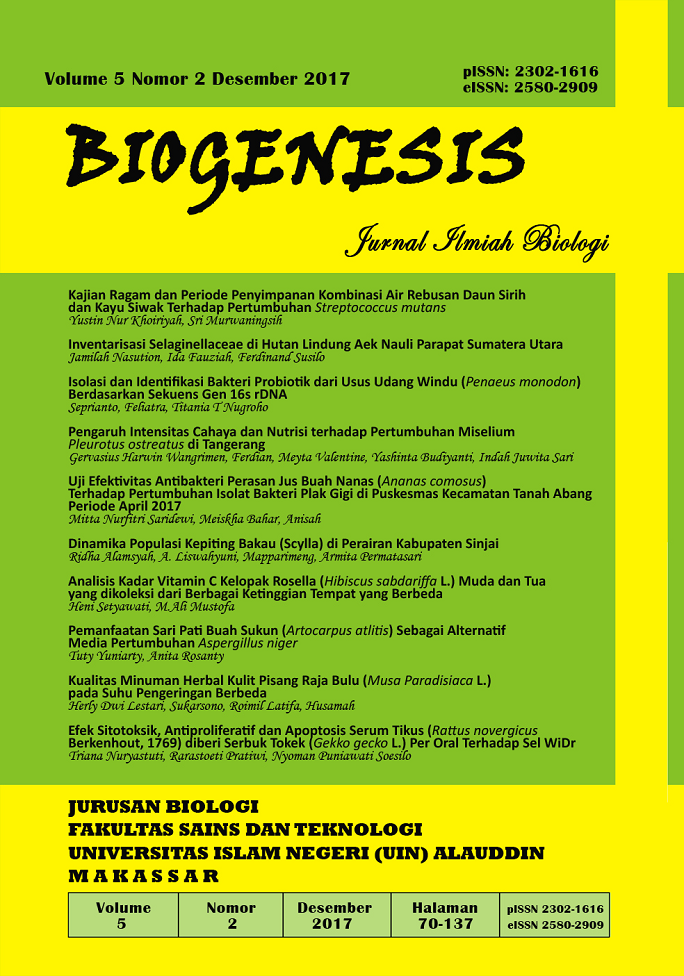Isolasi dan Identifikasi Bakteri Probiotik Dari Usus Udang Windu (Penaeus monodon) Berdasarkan Sekuens Gen 16S rDNA
Abstract
Probiotics are living microorganisms that have beneficial effect on the host by improving the balance of bacteria in the intestines. This research was aimed to determine the diversity of bacteria that live in digestion of the shrimp and molecular characteristics along with to observe phylogenetic relationships among the bacteria identified based on sequence16S rDNA. The bacteria were isolated from intestine of the Tiger prawn (Penaeus monodon) obtained from fishpond at BBPBAP Jepara. The analyzed result of 16S rDNA shown that three bacterial species were potential as probiotic. These bacteria grow well at pH 2 and this indicates one of probiotic bacteria characteristic. Among the three isolates, two isolates i.e. SP2 and SU isolates were phylogenetically closely related to Bacillus bataviensis strain CCGE2059 (EU867382.1) with 97% homology. While the SWU Isolate is most likely a new species of Caulobacter sp. (AJ227775.1). The SWU isolates were phylogenetically one ancestor with the Chromobacterium violaceum.References
Altschul SF, Gertz EM, Agarwala R, Schäffer AA, Yu YK. 2009. PSI-BLAST: psedocount and the minimum description length principle. Nucleic Acid Res. vol 37(3): 815-824. https://doi.org/10.1093/nar/gkn981.
Bijanti R, Wahjuni RS. Yuliani MGA. 2009. Suplementasi Probiotik Pada Pakan Ayam Komersial Terhadap Produk Metabolik Dalam Darah Ayam. J. Penelit. Med. Eksakta. vol 8(3): 178-184.
Cherif A, Ouzari H, and Deffonichio. 2001. Thuricin 7: A Novel Bacteriocin Produced by Bacillus sp BMGI a New Strain From Oil. Letter in Applied Microbiology. vol 32(4): 243-247.
Cowan and Steel’s. 2004. Manual for the Identification of Medical Bacteria. 3rd Edition. UK: Cambriage University Press
Gaggia F, Mattarelli P, Biavati B. 2010. Probiotics and Prebiotics in Animal Feeding For Safe Food Production. International Journal of Food Microbiology. vol 141: S15-S28. https://doi.org/10.1016/j.ijfoodmicro.2010.02.031.
Hagström A, Pinhassi J, Zweiefel UL. 2000. Biogeoghraphycal Diversity Among Marine Bacterioplankton. Aquatic Microbial Technology. vol 21: 231-244.
Heyman J. Vanparys B, Logan NA, Balcaen A, Rodríguez-Díaz M, Felske A, De Vos P. 2004. Bacillus novalis sp, Nov., Bacillus vireti sp. Nov., Bacillus soli sp. Nov., Bacillus bataviensis sp nov., and Bacillus dretensis sp., From The Drentse a Grasslands. International Journal of Sytematic and Evolutionary Microbiology. vol 54: 47-57. https://doi.org/10.1099/ijs.0.02723-0.
Lane DJ. 1991. 16S/23S rRNA Sequencing. In Stackebrandt, E. and Goodfellow, M., Eds., Nucleic Acid Techniques in Bacterial Systematic. New York: John Wiley and Sons. pp 115-175.
Liu D, Du L, Yu J, Li L, Ai Q, Feng J, Song C. 2015. 16S rDNA PCR-DGGE and sequencing in the diagnosis of neonatal late-onset septicemia. Mol Med Rep. vol 12(4):6346-52. https://doi.org/10.3892/mmr.2015.4131.
Marchesi JR, Sato T, Weightman AJ, Martin TA, Fry JC, Hiom SJ, Wade WG. 1998. Design and evaluation of useful bacterium-spesific PCR primers that amplify genes coding for bacterial 16S rRNA. Appl Environ Microbiol. vol 64(2): 795-799.
Nur F, Hafsan, Wahdiniar A. 2015. Isolasi Bakteri Asam Laktat Berpotensi Probiotik Pada Dangke, Makanan Tradisional dari Susu Kerbau di Curio Kabupaten Enrekang. Biogenesis. vol 3(1): 60-65. https://doi.org/10.24252/bio.v3i1.568.
Yarza P, Richter M, Peplies J, Euzeby J, Amann R, Schleifer KH, Ludwig W, Glöckner FO, Rosselló-Móra R. 2008. The All-Species Living Tree Project: a 16S rRNA-based phylogenetic tree of all sequenced type strains. System. Appl. Microbiol. vol 31(4): 241-250. https://doi.org/10.1016/j.syapm.2008.07.001.
Tamura K, Stecher G, Peterson D, Filipski A, Kumar S. 2013. MEGA 6: Molecular Evolutionary Genetics Analysis Version 6.0. Molecular Biology and Evolution. vol 30(12): 2725-2729. https://doi.org/10.1093/molbev/mst197.
Verschere L, Rombaut G, Sorgeloos P, Verstraete W. 2000. Probiotic bacteria as biological control agents in aquaculture. Microbiol Mol Biol Rev. vol 64(4): 655–671.
Vinoj G, Vaseeharan B, Thomas S, Spiers AJ, Shanthi S. 2014. Quarum-Quenching activity of The AH-Lactonase from Bacillus licheniformis DAHBI Inhibits Vibrio Biofilm Formator In Vitro and Reduces Shimp Intestinal Colonisation and Mortality. Marine Biotechnology NY. vol 16(6): 707-715. https://doi.org/10.1007/s10126-014-9585-9.
Větrovský T, Baldrian P. 2013. The Variability of the 16S rRNA Gene in Bacterial Genomes and Its Consequences for Bacterial Community Analyses. PloS ONE. vol 8(2): e57923. https://doi.org/10.1371/journal.pone.0057923.
Xi Z, Liu L, Davis CC. 2015. Genes with Minimal Phylogenetic Information are Problematic for Coalescent Analyses when Gene Tree Estimation is Biased. Molecular Phylogenetics and Evolution. vol 92: 63-71. http://dx.doi.org/10.1016/j.ympev.2015.06.009.
Copyright (c) 2018 Seprianto S, Feliatra F, Titania T Nugroho

This work is licensed under a Creative Commons Attribution 4.0 International License.
COPYRIGHT AND LICENSE STATEMENT
COPYRIGHT
Biogenesis: Jurnal Ilmiah Biologi is published under the terms of the Creative Commons Attribution license. Authors hold the copyright and retain publishing rights without restriction to their work. Users may read, download, copy, distribute, and print the work in any medium, provided the original work is properly cited.
LICENSE TO PUBLISH
1. License
The use of the article will be governed by the Creative Commons Attribution license as currently displayed on http://creativecommons.org/licenses/by/4.0.
2. Author’s Warranties
The author warrants that the article is original, written by stated author/s, has not been published before, contains no unlawful statements, does not infringe the rights of others, is subject to copyright that is vested exclusively in the author and free of any third party rights, and that any necessary written permissions to quote from other sources have been obtained by the author(s).
3. User Rights
Under the Creative Commons Attribution license, the users are free to download, reuse, reprint, modify, distribute and/or copy the content for any purpose, even commercially, as long as the original authors and source are cited. No permission is required from the authors or the publishers.
4. Co-Authorship
If the article was prepared jointly with other authors, the corresponding author warrants that he/she has been authorized by all co-authors, and agrees to inform his/her co-authors of the terms of this statement.
5. Miscellaneous
Biogenesis: Jurnal Ilmiah Biologi may conform the article to a style of punctuation, spelling, capitalization, and usage that it deems appropriate. The author acknowledges that the article may be published so that it will be publicly accessible and such access will be free of charge for the readers.


